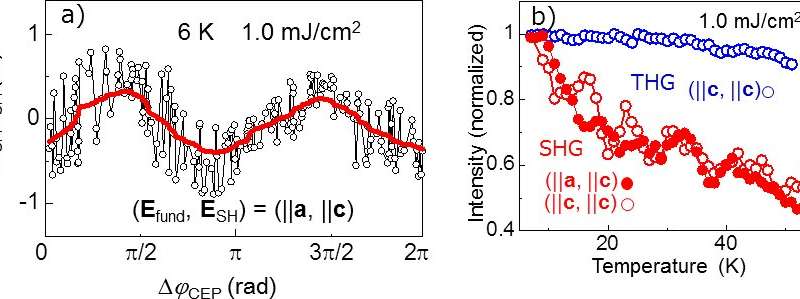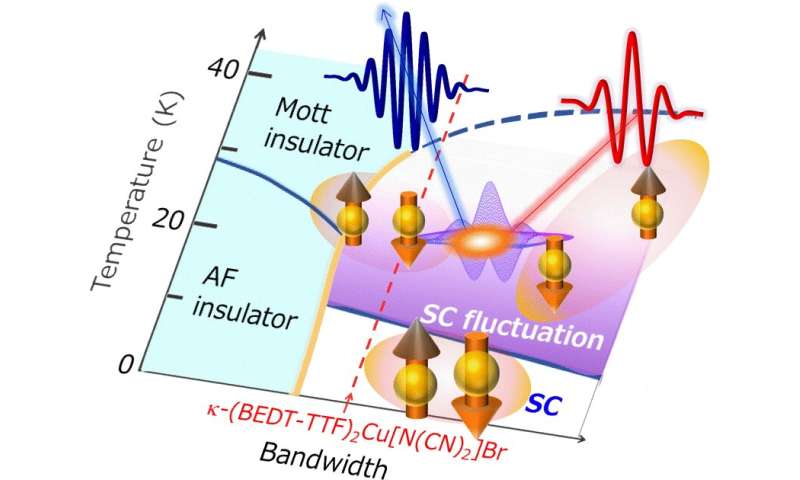#Electric current is manipulated by light in an organic superconductor
“#Electric current is manipulated by light in an organic superconductor”

According to Ohm’s law, an induced current (and velocity of electrons) is proportional to the applied electric field. Note that Ohm’s law holds, if the electrons are scattered many times in solids. In fact, the resistivity of the materials is determined by the electron-electron and/or electron-phonon scattering processes. If the electric field can be applied on the time scale shorter than the scattering time, however, the electrons in solids do not have enough time to be averaged. Instead, the electrons should be accelerated and generate a polarized net current. Therefore, the researchers have attempted to realize such a ‘scattering-free current’ using ultrashort laser pulses which are sufficiently shorter than the electron scattering time (about 40 femtoseconds in organic superconductors).
One obstacle to realize such an experiment is that electric detection of such a short-time current is impossible. Therefore, the researchers employ the optical detection. Second harmonic generation (SHG) has been well known as the method for detecting electronic symmetry breaking such as a macroscopic dipole moment in ferroelectrics. The SHG can be also induced by the polarized current which is another type of the electronic symmetry breaking.
The researchers shine their ultrashort laser with a pulse width of about 6 fs (6 × 10-15 s) on an organic centrosymmetric superconductor, κ-(BEDT-TTF)2Cu[N(CN)2]Br, and detect a second harmonic generation (SHG). This is in contrast to the common sense because the SHG is generated only in the materials in which spatial symmetry is broken. Their detection of the SHG in the centrosymmetric material indicates that a polarized net current is generated during the light irradiation.

To confirm such a non-linear polarized current, the researchers investigate carrier-envelope phase (CEP; relative phase between the oscillation of light and its envelope) dependence of the SHG, because CEP sensitive nature is a characteristic behavior of the current induced SHG. A periodic change of the SHG intensity as a function of the CEP is an evidence that the observed SHG is actually attributable to the scattering-free current.
The researchers further demonstrate that the relation between the scattering-free current and the superconductivity. The present result (Fig. 2b) shows that the SHG is detected at the temperature range below 50 K (> superconducting transition temperature (TSC=11.5 K)). The result also shows the intensity of the SHG rapidly grows toward the transition temperature below 25 K (∼2 × TSC), indicating that the scattering-free current is sensitive to a “superconducting fluctuation”. In many superconductors, the superconducting fluctuation, or microscopic seeds of superconductivity, has been found at temperatures higher than the superconducting transition, and the increase in the intensity of the second harmonic seems to be related to the superconducting fluctuations.
The researchers say, “With further understanding of the scattering-free non-linear petahertz current, we may be able to make computers with an operation speed of petahertz which is million times faster than the present ones of gigahertz. This phenomenon can be used also as a tool to elucidate the microscopic mechanism of superconducting states, because it is sensitive to the superconducting fluctuation.”
More information:
Y. Kawakami et al, Petahertz non-linear current in a centrosymmetric organic superconductor, Nature Communications (2020). DOI: 10.1038/s41467-020-17776-3
Provided by
National Institutes of Natural Sciences
Electric current is manipulated by light in an organic superconductor (2020, September 4)
retrieved 4 September 2020
from https://phys.org/news/2020-09-electric-current-superconductor.html
This document is subject to copyright. Apart from any fair dealing for the purpose of private study or research, no
part may be reproduced without the written permission. The content is provided for information purposes only.
If you want to read more Like this articles, you can visit our Science category.
if you want to watch Movies or Tv Shows go to Dizi.BuradaBiliyorum.Com for forums sites go to Forum.BuradaBiliyorum.Com




